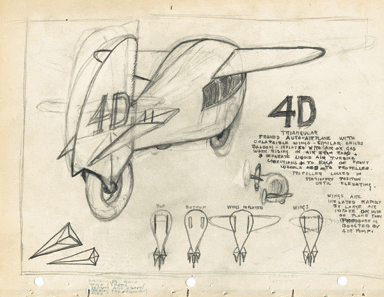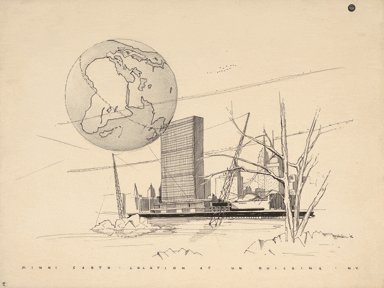
words Joseph Grima
Few figures in 20th-century design have perplexed the world as much as the self-proclaimed “anticipatory design scientist” Richard Buckminster Fuller. Einstein’s mind-bending intuitions redefined humanity’s understanding of space and time, but Fuller accomplished something possibly even less instinctual: he devoted his life to becoming, in his own words, “the world’s most successful failure”.
Buckminster Fuller: Starting with the Universe, on show at the Whitney Museum in New York, is the most comprehensive retrospective to date of the great American thinker and designer. Spread across an entire floor of the museum and a portion of the lobby, it is a treasure trove of some of the most famous and rare Fuller artefacts and memorabilia. No one who has studied architecture can fail to be moved by the original print of Fuller’s proposal for a glass dome stretching across central Manhattan like a vast but delicate soap bubble – one of the most iconic images of 20th-century utopian urbanism – or the early models for what would later evolve into his most famous invention, the geodesic dome.
Besides providing visitors with the unquestionable aesthetic and intellectual pleasure of a trip into Fuller’s multifarious universe, this timely show serves as an opportunity for the design community to re-evaluate the work of a man consistently considered an outsider. Having been kicked out of Harvard twice, Fuller never earned a degree, and learned everything he knew from day-to-day practice. Architects viewed him as a mad scientist, and the scientific community considered him an eccentric architect with scientist aspirations.
In truth, Fuller was the archetypal designer-inventor with an irrepressible entrepreneurial streak. He was given to setting up companies for the purpose of manufacturing his often flawed inventions, and the little profit that emerged from each of these ventures was almost invariably sunk into the next one. No field was beyond his irreverent reach – he even dabbled in dietetics and linguistics, and invented a new sleep regimen that he called Dymaxion Sleep. But, in the end, what is to be made of Bucky (as he was universally known) today?
Paradoxically, but perhaps not surprisingly, his most enduring influence has not been among architects but artists. Olafur Eliasson and Pedro Reyes quote him explicitly, and Londoners can visit the latest incarnation of Tomas Saraceno’s AirPort City encapsulated in a geodesic dome atop the Hayward Gallery. Fuller was a visionary capable of imagining a world less wasteful than the one he lived in, and the sum of his lifelong accomplishments is but a sketch, albeit of an entire parallel universe – a starting point rather than an end in itself.
Fuller was a great believer in the power of collaboration, which he theorised as the science of “synergetics”, and he would almost undoubtedly be proud of the synergy he has inspired among New York’s institutions. The Centre for Architecture has erected a Fly’s Eye dome and a special study centre in his honour; the Architecture League has organised a Fuller symposium; the New York Academy of Science has broadcast a podcast series; and for the most faithful, there is even a quote-spewing Twitter page (twitter.com/buckyfuller).
On leaving the exhibition, one has the distinct impression that those who consider Fuller a failure are measuring him against a system of coordinates that is not his own, and are lagging somewhere behind him. Among the many things he disapproved of was the Cartesian system of orthogonal coordinates, which he proposed to replace with a system based on a space-saving array of equilateral triangles. He set out not to design houses, invent automobiles or even write books, but to fulfil, to the maximum extent possible, his own potential and that of those around him. Many of his ideas, including the geodesic dome itself, have come into their own through the work of others. Precepts that he took for granted, such as the importance of humanitarian architecture and sustainable design, are only now understood.
This exhibition is a well-researched, lucid and thorough overview of Fuller’s work, and would be unmissable even solely as an opportunity to see one-of-a-kind artefacts such as the three-wheeled Dymaxion car or the early models for inhabited geodesic domes. Its great strength lies in the rigour with which Fuller’s prolific but chaotic oeuvre is systematised and recounted, with precise and fascinating biographic counterpoints, but that is also its greatest weakness. Fuller’s entire archive (which he called “The Chronofile”) is said to weigh 4.5 tonnes, and comprises thousands of drawings, plans, diagrams, models and samples; one cannot help but miss the information overload that characterised Fuller’s research process. The Chronofile was comprehensive to the point of being unintelligible, but accurately captures the spirit of this great intellectual omnivore’s attitude towards life. He was an inventor, but not of single objects: his whole life was devoted to the creation of a new world. Thanks to this exhibition, we are reminded that, 25 years after his death, the exploration of the world of R Buckminster Fuller has only just begun.
Buckminster Fuller: Starting with the Universe is at the Whitney Museum, New York, until 26 September.
top image Buckminster Fuller and Shoji Sadao Dome Over Manhattan, c 1960

image Courtesy of Estate of R Buckminster Fuller
US Pavilion Montreal Expo, 1967

image Courtesy of Ben Blackwell
Sketch for 4D Transportation Unit, c 1929

image Courtesy of Ben Blackwell
Minni Earth Location at UN Building, NY (drawing by Winslow Wedin), 1956















